When Chevrolet was developing its Vega model, they toyed with the idea of several different engine choices. Some proceeded as far as the prototype stage, but others were deemed unviable. While it was marketed as a subcompact, one car became home to an all-aluminum version of the 283 V8 that was bored to 302ci. Although it showed promise, the project never proceeded further and was scrapped in late 1972. Not to be deterred, the owner of this 1972 Vega GT Kammback Wagon has built his own interpretation of the prototype. Like the original vehicle, its engine bay also houses an aluminum V8. It runs and drives and needs somebody to perform a cosmetic refresh. Located in Smiths Grove, Kentucky, you will find the Vega listed for sale here on Craigslist. You could drive away in this interesting classic by handing the seller $7,800. I have to say a big thank you to Barn Finder Larry D for spotting this thought-provoking Wagon for us.
If potential buyers consider dropping their hard-earned cash on a Vega, this one is worth a closer look. Early examples were renowned for their rust issues (amongst other problems), but our feature Wagon has spent its life in the drier climes of Arizona. That means that any rust problems are confined to little more than surface corrosion. Don’t get me wrong, because there is a reasonable amount of corrosion, but it hasn’t deteriorated to penetrating rust requiring a grinder or welder. It is visible in various areas emerging from under the Code 65 Orange paint. If I were to buy this classic, addressing these issues would be a priority before they had a chance to deteriorate further. I’m not sure how easy it would be, but it could be worth sourcing a set of the inner fender liners that Chevrolet fitted from 1974 because that would reduce the chances of rust developing in the prone area between the inner fenders and the cowl. The panels have accumulated a few dings and bruises, but the buyer could easily repair these before applying a fresh coat of paint. Somebody has cut the front bumper to create an appearance reminiscent of the bumperettes from the Camaro RS, but with what appear to be raw edges where they are cut, the buyer may choose to source another bumper. The glass looks good, and the overall impression is that restoring the panels and paint should represent a straightforward cosmetic refresh.
Lifting the hood reveals this Chevy’s party piece. As a GT variant, its engine bay would originally have housed a 140ci four-cylinder engine producing 90hp. With a four-speed manual transmission bolted to that motor, this Kammback would have covered the ¼ mile in 18.2 seconds, which would hardly set pulses racing. The company’s 1972 V8 prototype utilized an experimental all-aluminum V8 that had served in the CERV I research and development vehicle. Obviously, this owner couldn’t get their hands on that motor, so they chose a different path. This V8 is also aluminum, but it started life in an early 1960s Oldsmobile. With a capacity of 215ci, it was a small motor by the era’s standards, but in unmodified form, it would have produced at least 155hp. That is a noticeable horsepower increase over the Vega’s original four, with the power finding its way to the rear wheels via a four-speed manual transmission. However, the reality may be slightly different because this V8 appears to wear an upgraded intake and carburetor. That could have pushed the power output even higher. The Kammback would originally have tipped the scales at 2,333lbs, and the new engine will not have added significantly to that figure. Therefore, I wouldn’t rule out this Wagon’s ability to cut a low-16-second ¼-mile ET. The seller bought the Vega as a non-running project a few years ago and worked through returning it to a roadworthy state. He replaced the carburetor, fuel pump, water pump, timing chain, timing gears, belts, hoses, wheel bearings, front suspension bushes, and reconditioned the radiator. He admits that the dual exhaust is cobbled together, so the buyer may want to fabricate something better. If you seek a turnkey classic, this appears to be it. The seller says that the Kammback runs and drives well, and with the extra power available, you would have to think it would be a riot when the driver pressed the pedal to the metal.
If the buyer wanted to save some money on this Vega’s refresh, they could get away with leaving the interior largely untouched. The headliner is missing, but it appears to be otherwise complete. The seat upholstery looks pretty respectable, as does the carpet. There is some wear visible on some of the door trim edges, but there are some high-quality vinyl dyes that could address that shortcoming for a few dollars. The factory radio has made way for a radio/cassette player, and there are some aftermarket gauges under the dash. It would look okay if the buyer cleaned everything and tied the loose wires hanging under the dash. If they wanted to improve the appearance further, they might consider searching for a headliner and an uncracked dash pad. If these are found at a reasonable price, they could prove a worthwhile investment.
The pages of motoring history books are loaded with “what if” moments, and the concept of a Vega V8 is one of them. Even in Kammback Wagon form, the Vega is not a heavy car. The Vega Cosworth experiment of 1975 and 1976 proved expensive and wasn’t the sales success the company envisaged. An all-aluminum V8 would not have added substantially to overall weight but offered the promise of greater power and torque than produced by the Cosworth motor. This GT Wagon may demonstrate what could have been, and it should provide an entertaining driving experience. The Vega is unlikely ever to make a Top 10 List of America’s most desirable classic cars, but would the mechanical upgrades be enough to tempt you to park it in your garage?






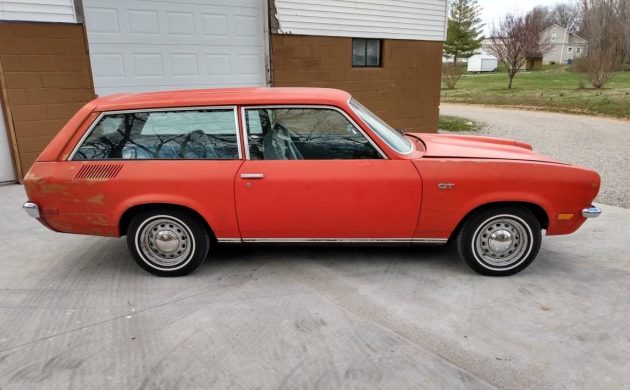

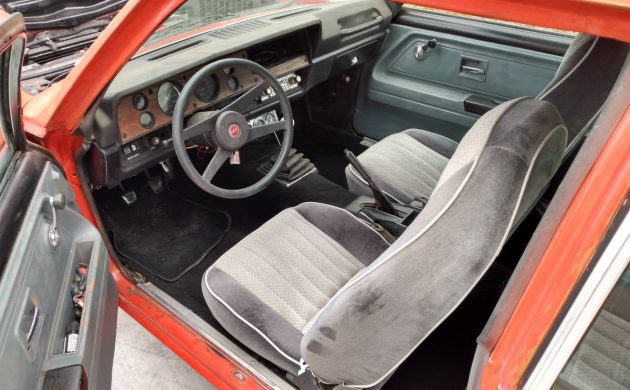
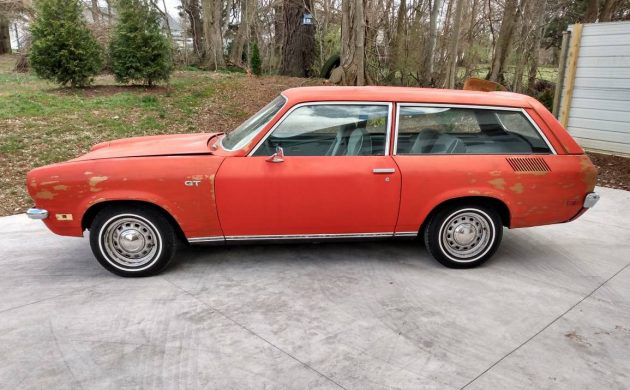

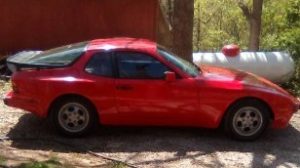
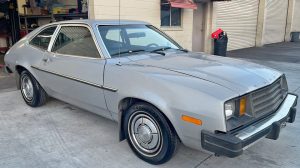



Lifting the hood reveals some jacked up wiring.
Wiring is easy to clean up and make right. Many people people just aren’t good at doing it. For the life of me I will never know why. I guess once it runs they consider it done.
Yeah, I’ve never understood why guys who built their own engines, fix their own brakes, etc, will run screaming like little girls when electrons are involved.
My biggest problem has been that the colors on the wiring fade in time, leaving me no option but to find a part of that particular wire that has not been exposed to sunlight, ozone, other types of smog etc.
I had 215 in my ’63 Skylark, good little motor, and a big improvement over the original Vega motor. Too bad GM sold all of the 215 stuff to British Leyland, they could have used that in the fwd Caddy de Villes instead of the 4100. I had one of those to, a whole other story. An aluminum 283 now that would be really cool.
That said this car looks like a lot of fun. and 4 speed, and a wagon. GM should have made this.
I had a 1962 Olds F85 with the 215 alum V8 back in college. It ran well, but the metallurgy used for the engine eventually caused a lot of corrosion internally in the engine. It continually ran very hot due this problem.
The problem wasn’t the metallurgy. The problem was that in the early 1960s people didn’t know anything about aluminum motors. They didn’t read the owner’s manual and just used tap water in the cooling system, which caused the deposits and corrosion. When I got my 62 F85 wagon that had been sitting in the Nevada desert for 30 years, the block had a corrosion hole in the cooling jacket from sitting so long with just water in it.
I built a 215-powered Vega wagon in the 1980s. Fun little car to drive around in. Unfortunately, despite the fact that the car had lived it’s entire life in SoCal, it still rusted out – including the TOPS of the front fenders. How does that even happen?
I remember when the Vegas first came out, my gear head friends made fun of them but I don’t remember why. The front end always reminds me of Camaros of the same vintage. This looks like a really fun car to drive.
Had a ’73 Kammback in this color. After 2 years and 45,000 miles, the motor started to burn oil so I traded it. Great car to drive, though, and the V8 solves the motor problem.
Great sleeper – What happens in Vega’s stays in Vega’s!
Awesome car…only 6-7000$ over the buy-price…close…but no cigar..love it nonetheless!
GM shipped these cars standing on end in rail cars. They’d get rained on, and water would creep into cavities it could never escape from. These cars were starting to rust even before they were sold.
Interesting piece of history. I wonder if anyone else transported cars that way and found similar issues. I’m guessing that isn’t done anymore.
Cool, posted 23 days ago, is the hood closed? Yes a rainbow of wires.
Strange, there is a 75 Vega GT Surf Wagon that has been for sale probably for at least a month now in N. Florida Craigslist. Wonder why? The Ron Jon can be painted over.
This 72 Vega Kammback is a nice upgrade with the current engine.
The description includes mention of a prototype with an aluminum V8. Here’s the rest of the story.
In 1971, there was a short animation, entitled “The Crunch Bird” that was created by Ted Petok, who worked for Jam Handy Corporation, a Detroit company that make advertising films for Chevrolet. It won an Oscar. You can find bootleg copies on YouTube. I was learning how to be a race engineer as the junior member of the Herb Adams-led team that raced The Gray Ghost in the 1971 Trans-Am series. Herb’s special products group had built a Pontiac Sunbird V8, and they were talking about this V8 Vega prototype, painted the same shade of blue as the bird in the cartoon, and nicknamed, “The Crunch Bird”. You have to watch the cartoon, but the basic idea was, “Crunch Bird, the road!”
A few weeks later, I was at my parents’ home, when my dad returned from the grocery store, having taken by ’68 Z28. It had a blueprinted motor, but with a M22 rock crusher with a 2.20:1 first gear and a 3.70:1 rear axle, it wasn’t much off the line. My dad wasn’t even all the way through the door carrying a couple of grocery bags and exclaimed, “I just got beaten by a Vega.”
“Was it blue?” I asked.
Suprised, he said, “How did you know?”
I told him I had heard about what must have been the car he tangled with at a stoplight.
He was in charge of GM’s market research/analysis group, and a week later, he brought it home overnight. It showed up in the magazines soon after, but by then, they had added some white stripes, which ruined its stealth.